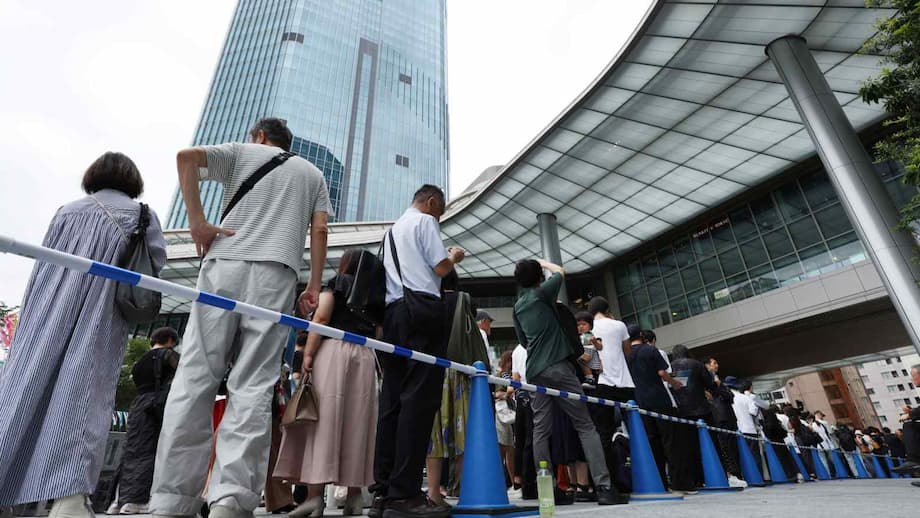A new kind of Tokyo mall experience
Tokyo’s newest retail destination is built to be more than a place to buy things. NEWoMan Takanawa, rising within the vast Takanawa Gateway City development in Minato ward, is positioning itself as an experience led mall where views, gardens, culture, and technology share top billing with shops and restaurants. Early visitors are finding spaces designed for lingering, from a large reading lounge to rooftop greenery, plus sightlines that, on clear days, reach all the way to Mount Fuji. It is a pointed response to how people spend time and money today, and a sign of how Japanese malls are evolving into full day destinations.
The project sits alongside Takanawa Gateway Station on the JR Yamanote Line, one stop from Shinagawa. The mall is opening in stages through 2026, rolling out new terraces, stores, and amenities as the surrounding smart city continues to take shape. For travelers, the appeal is straightforward: direct station access, a mix of local and international brands, and a setting that frames Tokyo in fresh ways, high above the tracks and gardens that weave through the district.
Inside Takanawa Gateway City
Takanawa Gateway City opened to the public in late March 2025 as a flagship redevelopment led by JR East. The complex spans hundreds of thousands of square meters and is funded at a scale that reflects its ambition. Planners describe it as a living laboratory for urban life, guided by a concept that looks a century ahead. The site blends offices, residences, hospitality, and culture with wide plazas and an integrated park. NEWoMan Takanawa is the retail core, connected directly to the rail station and to a web of indoor and outdoor promenades.
The district is also a test bed for mobility and service tech. Small rideable platforms glide across Gateway Park, some powered by hydrogen. Robots patrol and clean, ferry small deliveries, and can bring ordered drinks to pick up points. An app helps visitors navigate these services, while AI powered vans offer flexible, on demand rides around the neighborhood. The Travel Service Center provides information in many languages, as well as virtual reality tools that preview trips across Japan, from heritage sites to regional food routes. Digital experiments extend to rail access too, where a prototype QR code gate shows how a ticketless future could work for both commuters and tourists.
Culture is part of the blueprint. The district hosts public art and pop up events, with a nighttime kinetic art bar concept that doubles as a gallery. A major cultural anchor, MoN Takanawa (the Museum of Narratives) designed by Kengo Kuma, is scheduled to open in 2026 with immersive storytelling exhibitions. Hotel guests will gain a bird’s eye view of it all from the JW Marriott Hotel Tokyo, which occupies high floors in a south tower and offers multiple dining venues, a pool, a spa, and quick connections to Haneda Airport.
What makes NEWoMan Takanawa different
The mall’s design leans into the idea that shopping has become social and sensory. Rather than packing every square meter with sales floor, NEWoMan Takanawa introduces green terraces, a rooftop garden, casual seating, and a large reading space that feels closer to a public lounge than a store. Many corridors are daylight filled and open to breezes, and several restaurants and cafes face outdoor decks. The effect is less bunker, more urban veranda, with sightlines across the station and city.
Views of Mount Fuji from the city
On clear days, especially in the crisp air of winter, visitors can catch views of Mount Fuji from upper levels and rooftops. Few Tokyo malls can claim a line of sight to Japan’s highest peak. The draw here is the experience of browsing or relaxing in spaces where the horizon line includes rolling foothills beyond the Tokyo skyline. Visibility in summer can be hazy, so staff encourage guests to check conditions and head up when the light turns sharp.
Rooftop gardens and promenades
Rooftop greenery is central to the mall’s identity. The gardens, scheduled to open in phases with a major terrace debut in autumn 2025, give families and office workers an easy place to step outside. Urban green helps cool heat islands and softens hard edges, and it sets the stage for small events, weekend markets, and seasonal displays. Pathways connect terraces to restaurant decks, so a coffee, a book, and a view can be part of the same visit.
A reading lounge on a generous scale
One floor features a large reading space with lounge furniture and a curated selection of books and magazines. It functions like a calm zone inside a busy district, a place to slow down between errands, rest with a pastry, or let kids browse picture books. The concept speaks to a broader goal across the complex: combine commerce with restorative spaces that make people want to stay longer.
Retail, dining and culture in one place
By 2026, the NEWoMan Takanawa retail footprint is slated to reach around 200 stores across several buildings linked to the station. Early tenants include Japanese and global labels, specialty design shops, and cafes. Blue Bottle Coffee pours near sculptural flower displays at Nicolai Bergmann’s boutique, a pairing that foregrounds the district’s design sensibility. The Maison Classic lineup shows off contrasting food moods in one zone, from a cream puff factory and takeaway counter to a refined tea salon and a casual cafe with sandwiches and gelato.
Cultural programming is already part of the visit. The Takanawa Gateway Theater screens free short films, and the color saturated “100 Colors Path” installation by artist Emmanuelle Moureaux offers a playful stroll through shade and time. As MoN Takanawa approaches its 2026 opening, expect more previews, pop ups, and workshops that connect brand events with museum programming, bringing art and storytelling into everyday shopping routes.
Dining is adding experimental choices as well. Japanese seafood company Maruha Nichiro, which has announced a rebrand to Umios in 2026, plans to open a restaurant inside NEWoMan Takanawa that features cultivated seafood. The stated goal is to build a new fish eating culture aligned with a Planetary Health Diet and to showcase next generation seafood supply. The opening is planned for September 2026, and the concept fits the district’s emphasis on innovation and sustainability.
Mobility and digital services tie it together
Part of the appeal of this district is how it blends physical design with software and service. Visitors can see how robots move through public space, learn how small hydrogen powered carriers work, and try on-demand rides that connect buildings without the friction of fixed routes. An app consolidates these features, while static exhibits explain where the technology is headed, including rail ticketing that uses QR codes instead of magnetic cards. Families with strollers or travelers with luggage benefit from wide, step free routes, smart elevators, and clear signage.
The Travel Service Center, located near the station core, functions like a digital concierge. Staff can help in many languages, and interactive screens highlight destinations across Japan. Virtual reality goggles present short previews of regional trips, which can help visitors decide on a day excursion or a longer itinerary. Services like this bridge NEWoMan Takanawa to the rest of the country, turning a shopping stop into a planning session for wider journeys.
Access and planning your visit
NEWoMan Takanawa is connected to Takanawa Gateway Station on the JR Yamanote Line. The location is one stop from Shinagawa, a major interchange that links to the Tokaido Shinkansen, and around 15 minutes by rail from Haneda Airport with a quick transfer. Entrances feed directly from the concourse into retail areas, and outdoor promenades lead to Gateway Park. Access by taxi or rideshare is straightforward thanks to dedicated drop off points around the complex.
The mall and wider district are opening in phases through spring 2026. That means some features, such as the largest rooftop garden and certain restaurants, come online over time. The cultural calendar also updates frequently with installations and pop up events. Travelers can check official visitor pages for current hours, openings, and event schedules, especially if they want to time a visit for a clear view of Mount Fuji or for a specific program in Gateway Park. For a practical overview of what is open now, the Tokyo tourism site provides timely updates on the complex’s attractions and technology demonstrations. A good starting point is the official overview of Takanawa Gateway City at GoTokyo.
Why this mall model is gaining ground
Japanese retail has been adjusting to two forces that shape how people shop. Online retail handles routine purchases with speed and convenience, while leisure time is increasingly spent on things that feel social or memorable. Malls that behave like transit oriented parks, culture hubs, and dining districts can pull people in for a few hours and keep them there. That mix supports retailers and restaurants, and it gives landlords flexibility to program space for events, exhibitions, and seasonal changes.
Tokyo has seen versions of this approach in recent years, from vertical gardens and observatories at Shibuya Scramble Square to art and green space at Tokyo Midtown and Roppongi Hills. NEWoMan Takanawa adds a new twist by embedding those ideas in a smart city test bed wrapped around a new rail station. The result is a place where a shopping trip can include a robot demo, a short film screening, a rooftop stroll, and a view of Mount Fuji if the sky cooperates.
Tourism adds another layer. International visitors have returned in large numbers, and many are staying near Shinagawa for quick connections to airports and bullet trains. A mall that caters to travelers with multilingual support, cashless payments, and spaces to rest between trains can serve both locals and visitors without feeling like a transit hall. The cultivated seafood concept arriving in 2026 suggests that dining will continue to push into new territory, matching the district’s role as a showcase for future facing ideas.
At a Glance
- NEWoMan Takanawa is part of Takanawa Gateway City beside Takanawa Gateway Station on the JR Yamanote Line.
- The complex opened to the public in March 2025 and is rolling out features in phases through spring 2026.
- The mall highlights views of Mount Fuji from upper levels and rooftops on clear days.
- Rooftop gardens and outdoor promenades are central to the design, with a major terrace scheduled for autumn 2025.
- A large reading space offers a calm lounge environment within the retail floors.
- About 200 stores are planned by 2026, plus cafes and restaurants such as Blue Bottle Coffee and Nicolai Bergmann’s floral boutique.
- Cultural attractions include art installations, free short films at Takanawa Gateway Theater, and the MoN Takanawa museum opening in 2026.
- Robots, hydrogen powered carriers, and AI ride services are being tested across the district.
- A cultivated seafood restaurant by Maruha Nichiro, rebranding to Umios, is planned for September 2026 inside the mall.
- Direct station access, proximity to Shinagawa, and quick rail links to Haneda Airport make the location convenient for visitors.




